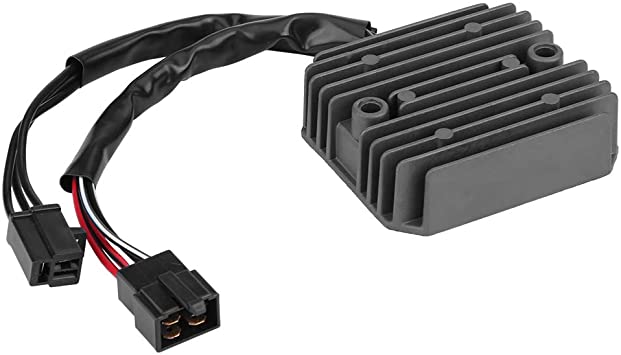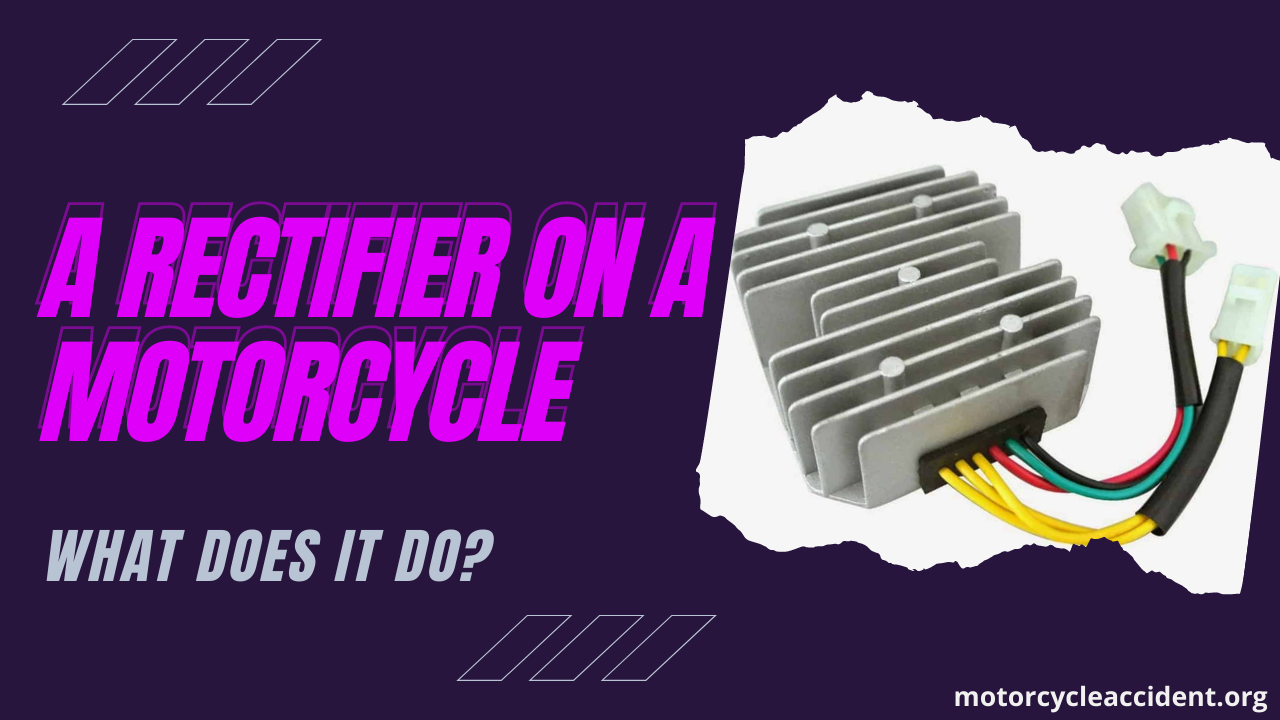If you’re new to motorcycles or just curious about the inner workings of your bike, you may have wondered what a rectifier does. A rectifier is an essential part of a motorcycle’s electrical system, and it plays a crucial role in keeping everything running smoothly. This blog post will discuss what a rectifier does and how it helps power your bike. We’ll also look at some of the common problems with a motorcycle rectifier and provide some tips for fixing them.
What is a Motorcycle Rectifier?
A motorcycle rectifier is a component of the electrical system in a motorcycle. It acts as an intermediary between the battery and the rest of the electrical components, ensuring a steady current is supplied to these other parts. The rectifier helps regulate voltage and stabilize the electrical supply, minimizing fluctuations that can cause damage to delicate electronic systems. Additionally, by providing a steady stream of power to these other components, the rectifier helps prevent overheating and extends the overall lifespan of the motorcycle. Whether you’re a long-time rider or just getting started with motorcycling, it’s essential to know what a rectifier is and how it works to keep your bike running smoothly for years to come!
What does a Motorcycle Rectifier do?
A motorcycle rectifier is a device that serves an essential function in the operation of a motorcycle. Essentially, it converts alternating current (AC) into direct current (DC), allowing electricity to be distributed appropriately across the vehicle’s various components. It will enable critical systems like the ignition, lights, and electrical accessories to function smoothly and effectively. In addition to its crucial role in the smooth running, the rectifier is also responsible for maintaining battery charge and reducing voltage fluctuations while the engine is running. Overall, a motorcycle rectifier plays an essential role in ensuring that your bike operates at peak efficiency.
How should I know if the Motorcycle rectifier needs to be replaced?
You’ll know it’s time to replace the motorcycle rectifier if you notice any of the following problems: the headlights are dimming, the battery isn’t charging, or the electrical system is overheating. If you’re experiencing any of these issues, it’s best to take your bike to a mechanic and have them take a look. They’ll be able to tell you for sure whether or not the rectifier needs to be replaced. In some cases, it may just need to be cleaned or repaired. However, if it’s genuinely shot, you’ll need to get a new one. Luckily, they’re not too expensive and can usually be found at most auto parts stores. So if you think your motorcycle rectifier might be on its last legs, don’t hesitate to get a new one – it could end up saving you a lot of hassle (and money) in the long run.

How to replace motorcycle rectifiers?
Replacing a motorcycle rectifier is a relatively easy task that can complete in an afternoon with just a few tools. First, remove the old rectifier by unscrewing the bolts that hold it in place. Next, disconnect the wires that are attached to the rectifier. Once the old rectifier is removed, install the new rectifier in the exact location and reattach the wires. Finally, screw the new rectifier into place and test it to ensure it is working correctly. With time and effort, anyone can replace their motorcycle rectifier.
How to Clean motorcycle rectifiers?
To clean the vehicle’s rectifiers, the first step is to disconnect the battery. It will prevent you from getting zapped while working with electricity near the inner circuit of the rectifier. Once you have safely disconnected the battery, wipe off any dirt or grime that may be present around the rectifier with a damp rag. You can also use some mild adhesive remover to loosen tougher dirt or residue buildup around the rectifier. Then, you may want to apply a coat of spray lubricant around any electrical connections on or near the rectifier for extra protection. Finally, let everything dry completely before reconnecting your battery and starting up your bike. With these simple steps, you can easily clean and maintain your motorcycle’s rectifiers and keep them working at peak performance for years to come!
FAQs about motorcycle rectifiers
A motorcycle rectifier is a critical component in the electrical system, converting alternating current (AC) into direct current (DC). Motorcycle rectifiers are typically located under the seat or on the side of the engine and are usually made of metal. While most motorcycle rectifiers are durable and long-lasting, they can occasionally fail. If you’re having trouble with your motorcycle’s electrical system, some FAQs may help.
How do you choose a motorcycle rectifier?
Many different factors can influence your decision when choosing a motorcycle rectifier, including your budget, bike’s size and voltage requirements, and the features you need. Key considerations include efficiency ratings, circuit protection specifications, pulse width modulation technology, amperage ratings, cooling system selections, weight limitations, and warranty. Ultimately, the suitable rectifier for your bike will depend on your individual needs and preferences.

How to replace motorcycle rectifiers?
Replacing a motorcycle rectifier is a relatively easy task that can complete in an afternoon with just a few tools. First, remove the old rectifier by unscrewing the bolts that hold it in place. Next, disconnect the wires that are attached to the rectifier. Once the old rectifier is removed, install the new rectifier in the exact location and reattach the wires. Finally, screw the new rectifier into place and test it to ensure it is working correctly. With time and effort, anyone can replace their motorcycle rectifier.
How to Clean motorcycle rectifiers?
To clean the vehicle’s rectifiers, the first step is to disconnect the battery. It will prevent you from getting zapped while working with electricity near the inner circuit of the rectifier. Once you have safely disconnected the battery, wipe off any dirt or grime that may be present around the rectifier with a damp rag. You can also use some mild adhesive remover to loosen tougher dirt or residue buildup around the rectifier. Then, you may want to apply a coat of spray lubricant around any electrical connections on or near the rectifier for extra protection. Finally, let everything dry completely before reconnecting your battery and starting up your bike. With these simple steps, you can easily clean and maintain your motorcycle’s rectifiers and keep them working at peak performance for years to come!
FAQs about motorcycle rectifiers
A motorcycle rectifier is a critical component in the electrical system, converting alternating current (AC) into direct current (DC). Motorcycle rectifiers are typically located under the seat or on the side of the engine and are usually made of metal. While most motorcycle rectifiers are durable and long-lasting, they can occasionally fail. If you’re having trouble with your motorcycle’s electrical system, some FAQs may help.
How do you choose a motorcycle rectifier?
Many different factors can influence your decision when choosing a motorcycle rectifier, including your budget, bike’s size and voltage requirements, and the features you need. Key considerations include efficiency ratings, circuit protection specifications, pulse width modulation technology, amperage ratings, cooling system selections, weight limitations, and warranty. Ultimately, the suitable rectifier for your bike will depend on your individual needs and preferences.

How do I test my motorcycle rectifier?
A: Testing your motorcycle rectifier is relatively simple. First, make sure that all connections are tight and free of corrosion. Next, check the voltage output of the rectifier using a multimeter. If the voltage output is below 12 volts, it’s likely that the rectifier is failing and needs to be replaced.
What are some common problems with motorcycle rectifiers?
Issues with a motorcycle rectifier can vary depending on the specific model and type you have. For example, some models may overheat due to insufficient cooling mechanisms or defective heat sinks. Other common issues include loose electrical connections, water damage, short circuits, and blown fuses. If you’re having trouble with your rectifier, it’s best to take it to a mechanic or an experienced bike technician for help.
How often should I replace my motorcycle rectifier?
Most rectifiers will last for many years with proper care and maintenance. However, if you notice any problems with your rectifier, such as dimming lights or unusual noises, it’s best to take it to a mechanic for a checkup. The rectifier may need to be cleaned or repaired in some cases. However, if it’s genuinely shot, you’ll need to get a new one. Luckily, replacing a motorcycle rectifier is usually relatively easy and inexpensive.
What is the best brand of motorcycle rectifiers?
There are a few different brands of motorcycle rectifiers on the market. Each brand has its strengths and weaknesses. Some brands are more durable than others. Some have better customer service. And some are more affordable. It depends on your priorities when choosing a brand of motorcycle rectifier. If you’re looking for the most durable rectifier, you’ll want to go with a brand like Schumacher or Moeller. If you’re looking for the best customer service, you’ll want to go with a brand like OEM or Genuine. And if you’re looking for the most affordable option, you’ll want to go with a brand like Aftermarket or Generic. Ultimately, it’s up to you to decide which brand of motorcycle rectifier is right for you.
Where Can I buy motorcycle rectifiers?
There are a lot of different places where you can buy motorcycle rectifiers. Some of the most popular options include large online retailers like Amazon or eBay and specialized motorcycle shops or parts stores. Of course, you can sometimes find rectifiers for sale in local classifieds or garage sales, though the selection and quality may not be as good in these settings. Ultimately, the best way to choose where to buy your motorcycle rectifier will depend on your needs and preferences. For example, if you’re looking for a bargain, online retailers may be your best bet, while if you want to talk to someone directly about the rectifier that’s right for you, shopping at a local store may be more appealing. No matter which option you choose, do your research first to get the best product and price possible.
How much are motorcycle rectifiers?
There’s no one-size-fits-all answer to this question, as the cost of motorcycle rectifiers can vary depending on several factors. However, you can expect to pay anywhere from $40 to $200 for a quality rectifier. If you’re on a budget, you may be able to find a lower-priced option, but keep in mind that you’ll get what you pay for. In general, it’s worth spending a little extra to get a rectifier that will last.
Conclusion
So there you have it! That’s what a rectifier does on a motorcycle – it converts the AC from the stator into DC so that the battery can store and use it. It’s an essential part of the electrical system, and if it goes out, your bike won’t run. Hopefully, this article has helped you understand how your bike’s electrical system works – now go out and ride safe!





